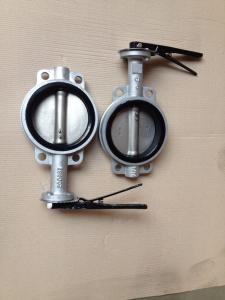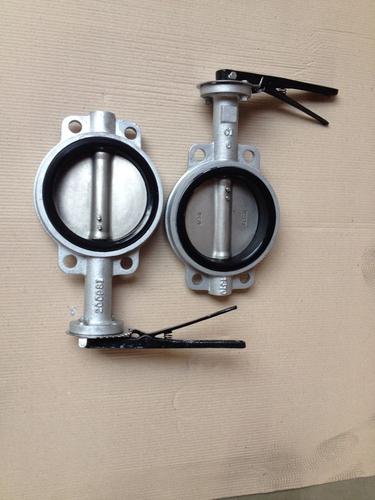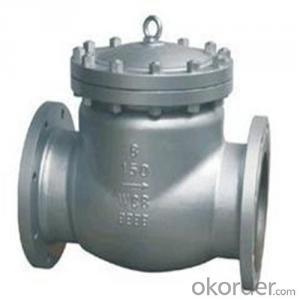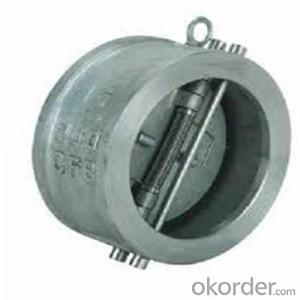Ductile Iron wafe type butterfly valve
- Loading Port:
- China Main Port
- Payment Terms:
- TT OR LC
- Min Order Qty:
- -
- Supply Capability:
- -
OKorder Service Pledge
OKorder Financial Service
You Might Also Like
Specifications
Double flanged Double Eccentric Butterfly Valve
PN10/16/25
DN100 ~ DN2000
Technical Specifications
- Design and manufacture: EN593, EN1074-1 and 2
- Face to face dimension: EN558-1 Series 14 (DIN3202 F4)
EN558-1 Series 13 (BS5163)
- Flange dimensions and drillling: EN1092-2 PN10/16/25
- Size range: DN100 - DN2000
- Max. working pressure: 1.0/1.6/2.5 MPa
- Inspection test: EN12266
- Working temperature: -15°C to +80°C
- Suitable medium: water
Main Fetures
- Double eccentric disc reduces seal wear and torque
- Body seat ring is welded directly on the body
- Bi-directional flow and low head loss
- Disc sealing ring to be replaceable on pipeline without dismantling the valve
- Body and disc inside and outside epoxy powder coated (min. 250 microns)
- Opening and closing indicators are provided
- Coupling flange for electric actuator in compliance with ISO5211
- Gearbox and electric actuator operation available
Main Parts and Materials
Body and disc: ductile iron EN GJS500-7/400-15
Shafts: stainless steel AISI 420
Body seat ring: stainless steel AISI 304
Disc sealing ring: EPDM or NBR
Retaining ring: stainless steel or ductile iron
Shaft bearing: Du bushes (self lubricating bushes)
- Q: A diabetic patient undergone CABG having aortic valve problem.Cardiologist suggested valve replacement
- Can be cured by valve replacement... alternatively, if you can't/won't go through open heart surgery then you may be able to get valvuloplasty. A balloon is used to stretch the valve open. This does not last nearly as long as replacement, but avoids surgery. A third alternative would be to contact one of the percutaneous valve REPLACEMENT centers (Mayo, Cleveland Clinic, Columbia). This is an experimental procedure which replaces the valve using catheters instead of surgery. Advice offered here is not meant to be a replacement for proper evaluation and examination by a qualified medical professional and should not be construed as such.
- Q: I couldn't get a name off the valve as it sits. It has a leak on the top plate and i'd like to replace the valve plate as opposed to cutting the whole thing out and replacing.
- I dont think they sell just the top plate by itself even if you could determine the mfgd. Cut out the entire old valve and replace it. Its not that big of a job.
- Q: so do v-6 engines mean 6 cylinders right?, but what are valves? sometimes they are like double the cylinders (12 valve v6). what do they do, and cars that have like 2.5L does that mean how much fuel is injected and does more mean more power?on a side note, what kind of engine is the evo x? is it 4 cylinder? but has really good technology in it and is that how it has such high bhp?also if anyone knows, i kinda know what torque is but can someone explain in laymen terms? does more=better?
- Yes v6 means 6 cylinders (pistons). Each pistons need to have gas come in and out and so the valves open and close to do exactly that (breath). There are at least 2 valves per piston - one (set) for exhaust and another for intake. Sometime to make it breath easier, there are 2 valves on each set. The 2.5L mean 2.5 liters (the measurement of the pistons) or basically the engine. The larger the displacement the more powerful (theoretically). Of course the larger the displacement the more fuel need to be injected. The exception is TURBO charged engines which stuff extra air (and extra fuel) so even a small engine take more fuel than equal non-turbo engie. The Evo uses much more than high tech engine to be that good. Besides being powerful, it uses the computer to divide the power to all 4 wheels in such a way to keep the car pulling even in a hard turn. === The TORQUE is the actual measure of engine power. The horse power is a translation of torque into something that people understand (horse - power). Good Luck...
- Q: I need the valves that I need to press down for the notes on the bass stave. Can someone please write them down for me in a list like this?F = openG = 1 and 3A = 1 and 2 etc.Thanks people.
- Try okorder
- Q: if safe, at what age should a woman with mitral valve prolapse be pregnant?
- It is fine as long as your doctor monitors you and knows your level of regurgitation. Please report any new palpitations at once. You must keep your blood pressure under control also. Congrats!
- Q: Hi all,My 1995 nissan altima (122k on the odometer) stalled for a few minutes this morning. I noticed that one of the sparkplug holes ( where the cable from the distributer connects to the spark plug) is sorrounded by oil. I cleaned it out and it got filled with oil again. luckily for me, and by god's grace it somehow started normally and i drove home. I am sure its the valve gasket. There is not much oil leakage, the oil level is fine.I need to know if its going to damage my engine if I ignored the problem for 3-4days.Thanks.
- that guy sleepydo DOES NOT KNOW WHAT HE IS TALKING ABOUT..........no it wont damage a thing ......just keep an eye on your oil level...and make sure it stays full.....just have youre valve cover replaced pretty soon...
- Q: My cougar needs new EGR valve. They squeezed the 4.6 litre engine into it. My question is, how hard is it to get out and then back in? I can barely see the top of it behind the intake manifold so don't want to get it off and not be able to get it back in. What size bolts hold it in? I'm sure they are metric. Any help would be greatly appreciated.
- I would worry less about the mount bolts and more about getting the pressure fittings off. These can be a real bear if you haven't done a thousand of them. You may have to cut some cheap wrenches in half to gain access to them or use crowfoot wrenches or alot of heat without melting fuel lines, engine parts ect.
- Q: I went look at a car, and the guy selling the car said that the engine valve is leaking. Is this a big deal? How urgent would it need to be fixed? How much would that cost?
- He most likely told you the valve cover is leaking. The words engine valve leaking don't make any sense or point to anything else. The valve cover covers the valves which have oil splashing around Sometimes the gasket that keeps the cover from leaking dries out and breaks. Then oil seeps out onto the engine. It's not an urgent fix. But then it's quick and cheap to fix, so most people fix it.
- Q: My friend is having 3 valves in her heart replaced with pig valves. Her dr said that putting in human valves raises the risk of her body rejecting them but wouldnt your body also reject a part form different species? And if they only last a few years why use them at all? shes all freaked out about the surgery so I dont want to ask her too many questions
- This Site Might Help You. RE: why do they use pigs heart valves for humans? My friend is having 3 valves in her heart replaced with pig valves. Her dr said that putting in human valves raises the risk of her body rejecting them but wouldnt your body also reject a part form different species? And if they only last a few years why use them at all? shes all freaked out...
- Q: What exactly is a flow valve for an ice maker on a refrigerator? Any idea what it would cost to replace it? Is it easy to replace?
- google repairing flow valve on ice maker it is there.
Send your message to us
Ductile Iron wafe type butterfly valve
- Loading Port:
- China Main Port
- Payment Terms:
- TT OR LC
- Min Order Qty:
- -
- Supply Capability:
- -
OKorder Service Pledge
OKorder Financial Service
Similar products
Hot products
Hot Searches
Related keywords


























